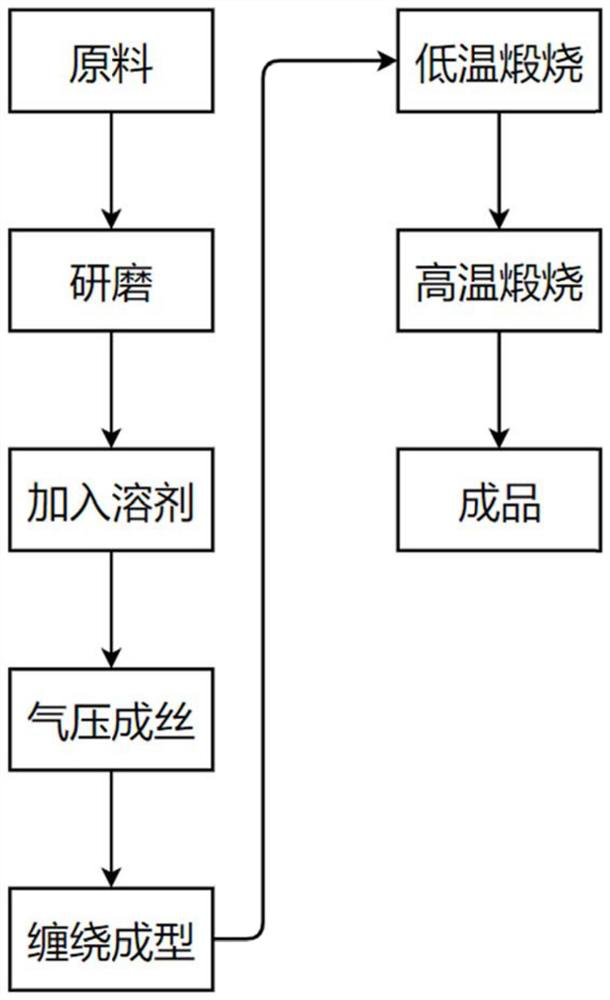Sponge ceramic catalyst and its preparation method and application in tap water treatment
A ceramic catalyst and tap water technology, which is applied in catalyst activation/preparation, oxidized water/sewage treatment, water/sewage treatment, etc., can solve problems such as low specific surface area, difficult separation of impurities, unsatisfactory stability and mechanical strength, etc., to achieve The effect of large specific surface area, high economy and good socio-economic effect
- Summary
- Abstract
- Description
- Claims
- Application Information
AI Technical Summary
Problems solved by technology
Method used
Image
Examples
preparation example Construction
[0033] The process flow of the preparation method of the sponge ceramic catalyst of following embodiment is all as figure 1 shown, including steps:
[0034] (1) Grind and mix the raw materials evenly;
[0035] (2) adding solvent water to the raw material after grinding to form a colloid;
[0036] (3) colloidal air pressure into filaments to obtain filaments;
[0037] (4) winding and molding the filament to obtain a molded body;
[0038] (5) The formed body is calcined at low temperature to obtain the primary formed body;
[0039] (6) The primary molded body is calcined at high temperature to obtain a sponge ceramic catalyst.
Embodiment 1
[0041] (1) Raw materials: diatomite, zirconia, zinc oxide, sodium silicate, copper nitrate, iron nitrate, cerium nitrate, and platinum nitrate in a mass ratio of 15:6:3:3:2:1:1:1.
[0042] (2) Raw material pretreatment: mix the raw materials and put them into a ball mill to grind until they can pass through a 300-mesh sieve, and mix thoroughly to obtain a powder. Add water to the powder, the volume ratio is 1:4, mix well to form a colloid.
[0043] (3) Pneumatic molding: use a high-pressure molding machine to control the pressure at 300 MPa, extrude the colloid into filaments to obtain filaments, and wrap the filaments in a winding molding machine to form them.
[0044](4) Calcination stage: low-temperature calcination: put the winding molded body into the muffle furnace, and raise the temperature to 500°C at a rate of 5°C / min, keep it for 2h, and calcinate to remove the moisture mixed into the powder to obtain the primary Molded body; high-temperature calcination: raise the ...
Embodiment 2
[0047] (1) Raw material preparation: Diatomaceous earth, zirconia, zinc oxide, sodium silicate, copper nitrate, iron nitrate, cerium nitrate, platinum nitrate according to the mass ratio of 21:8:2:3:2:1:1:1 .
[0048] (2) Raw material pretreatment: mix the raw materials and put them into a ball mill to grind until they can pass through a 300-mesh sieve, and mix thoroughly to obtain a powder. Add water to the powder, the volume ratio is 1:4, mix well to form a colloid.
[0049] (3) Pneumatic molding: use a high-pressure molding machine to control the pressure at 500 MPa, extrude the colloid into filaments to obtain filaments, and wrap the filaments in a winding molding machine to form them.
[0050] (4) Calcination stage: low-temperature calcination: put the winding molded body into the muffle furnace, and raise the temperature to 500°C at a rate of 5°C / min, keep it for 2h, and calcinate to remove the moisture mixed into the powder to obtain the primary Formed body. High-tem...
PUM
 Login to View More
Login to View More Abstract
Description
Claims
Application Information
 Login to View More
Login to View More - R&D
- Intellectual Property
- Life Sciences
- Materials
- Tech Scout
- Unparalleled Data Quality
- Higher Quality Content
- 60% Fewer Hallucinations
Browse by: Latest US Patents, China's latest patents, Technical Efficacy Thesaurus, Application Domain, Technology Topic, Popular Technical Reports.
© 2025 PatSnap. All rights reserved.Legal|Privacy policy|Modern Slavery Act Transparency Statement|Sitemap|About US| Contact US: help@patsnap.com



